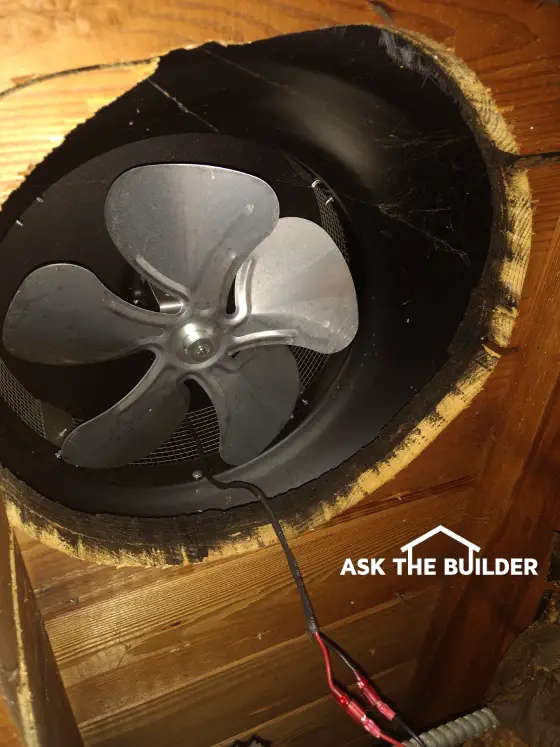Roof Ventilation Fan

This is a powered roof ventilation fan. You’re in the attic looking at the underside of the fan. (C) Copyright 2017 Tim Carter
Roof Ventilation Fan
DEAR TIM: I’ve got a two-year-old and eighteen months ago I moved into a gorgeous ranch home built in 1950. Money is tight and I don’t want to make mistakes. The house needs a new roof. I climbed into the attic and noticed foil-faced insulation is attached to the underside of the roof and I see I have a powered ventilation fan. The roofers want to put in a ridge vent and I’m afraid to cut into my precious roof. What would you do? Is the fan I have a good idea? Should there be more ventilation? What about soffit vents? The house has survived for sixty-seven years without them? I’ve been on countless blogs until 1 am until my eyes hurt and the information is so conflicting. Help me Tim! Stacey V., University Park, MD
DEAR STACEY: We’ve got lots of ground to cover and I’ve got limited space in this column. Let’s discuss the confusing information you’re seeing on the home improvement blogs.
I’ve had the good fortune to meet many of the bloggers at media events. When I chat with them, I quickly discover that most have never worked in or on the house of a paying customer. Most of the bloggers have day jobs and just an interest in home improvement. Some have worked on their own homes and think they’re now experts.
In my opinion, you need about twenty years or more of day-in day-out field experience working for paying customers to be able to give sound advice. From now on when you visit a home improvement blog, go to the About Us page first. If that blogger can’t convince you he/she has worked in the homes of paying customers for decades, you might want to leave that website and find one like mine.
I’ve worked on many 1950s ranch houses just like you bought. In fact, my in-laws house was nearly identical and I put a new roof on it back in the mid 1970s. Back in the 1950s weatherstripping was minimal, air leaks were plentiful and heating fuel was cheap. So much air leaked into and out of these houses that humidity issues were rare.
Fast forward and many of these houses now have new windows and doors that have great weatherstripping. Air leaks have been caulked. Your house may be one that’s been retrofitted and the indoor humidity can be much higher than fifty years ago because cold dry air in the winter can no longer mix with the more humid air you have inside your home.
This is why roof ventilation is now much more important. The humid air needs to get up into the attic, which it does with ease, and escape back outdoors as fast as possible. You want air moving through your attic, even if it’s just enough to move the smoke from a burning incense stick.
The roofers are giving you good advice. I’d recommend a continuous ridge vent to help exhaust humid air from your attic space. For these to work well, you absolutely need soffit vents to supply the incoming air into the attic.
You’ve got a powered roof ventilation fan that the previous owner installed. You need to test it to make sure it works. Most have a built-in thermostat where they come on a set temperature and then turn off when the attic cools down. I’d have the turn-on temperature set to 120 F and the turn-off temperature set to 95 F.
I’m a big fan of roof turbine vents. Some people call these whirlybirds. They look like small round mushrooms sticking out of your roof. The vents have blades that are shaped to capture the wind and then spin. This spinning motion sucks air from your attic.
They work for free and can suck hundreds of cubic feet of air per minute out of your attic if the wind is really blowing. I’ve had these at my last house for years and they worked very well and never ever leaked. I’d install two of these turbine vents on the back side of the roof as high up as possible but not so high as you can see them from the street.
Whoever installed the foil-faced insulation up against the underside of the roof made a big mistake. I’d remove that as soon as possible and lay it on the floor of the attic with the foil facing up towards the sky. The foil, as long as it’s dust-free, will act as a radiant barrier and reflect the invisible infrared rays generated by the hot roof system back away from the inside of your home.
The way the insulation is now installed can cause condensation to build up on the underside of the roof sheathing. It also makes your attic hotter in the summertime which then makes your air conditioning work harder.
When the sun heats up the roof system, the insulation and the air in your attic my rise to 140 F or more on a brutal summer day. This heat in the attic space can’t easily escape back out to the outside because the foil-faced insulation is keeping the heat in the attic space.
Column 1216
2 Responses to Roof Ventilation Fan